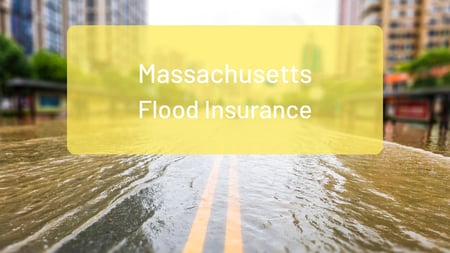Flooding is not only the most common natural disaster in the United States. It is also one of the most costly.
 Homeowner's insurance policies do not typically cover flood damage. To protect your home and belongings in the event of a flood requires a separate flood insurance policy.
Homeowner's insurance policies do not typically cover flood damage. To protect your home and belongings in the event of a flood requires a separate flood insurance policy.
Knowing how to buy flood insurance is the first step in helping you to protect yourself financially against potentially catastrophic flood damage. Read on to learn what flood insurance is, how to purchase it, who needs it, and when it's needed. This article also will examine the cost of Massachusetts flood insurance.
What is Flood Insurance?
The National Flood Insurance Program (NFIP) is a federal program managed by FEMA. The NFIP provides insurance to help reduce the socio-economic impacts of floods. Though administered by FEMA, NFIP is delivered to homeowners by a national network of more than fifty insurance companies and through NFIP Direct.
The essential design feature of the NFIP is that communities are not required to participate in the program by any law or regulation. Instead, communities in the United States voluntarily participate in the NFIP to secure access to the primary flood insurance offered by the NFIP.
Your home and your personal belongings are your most important financial assets. Floods can happen anywhere and at any time.
If your home is one of the 13 million American homes located in a high-risk flood area, you have a 26 percent chance of flooding during the time of a 30-year mortgage. That's far greater than the 10 percent risk of experiencing a fire during the same timeframe.
Just one inch of water pooled in a single-family, 1,000 square-foot home can cause nearly $11,000 worth of damage. In a 2,500 square-foot, single-family house, one foot of water can generate more than $29,000 in damage. Statistics show that people who live outside high-risk areas file more than 25 percent of flood claims nationwide.
Most homeowners' policies do not cover flood damage. Flood insurance is a separate policy written to protect buildings, their contents, or both.
Flood insurance can help property owners to recover faster when floodwaters recede. The NFIP works with communities required to enforce floodplain management regulations to help mitigate the effects of flooding. A flood insurance policy is available to anyone living in NFIP participating communities in Massachusetts and nationwide. Homes in high-risk areas with mortgages received from government-backed lenders must have flood insurance to receive funds.
Related: 7 Tips for Massachusetts Homebuyers Purchasing Homeowners Insurance
As of October 1, 2021, FEMA has a new risk-rating system, said Anthony Cingranelli, sales director for Ironside Insurance Group, LLC. The risk-rating change was the first since the Flood Insurance Protection Act, which requires the purchase of flood insurance for properties in high-risk flood zones, became law in 1973.
"Prior to the new rating system, your rate was determined solely based on the flood zone you were located in," Cingranelli said. "Now FEMA is considering more flood-risk variables when determining rates." Cingranelli added that the new system allows him to save some consumers money on flood insurance premiums.
What Does Flood Insurance Cover
FEMA provides policies that can help protect your home, personal belongings, or both. The basic coverage for these two types of insurance policies include:
Building Property Policy
What it covers – A Building Property Policy protects your home's physical structure, including the foundation, electrical and plumbing systems, HVAC, including detached garages. Built-ins, such as bookcases, cabinets, and paneling, are protected too. You will need a separate policy if you have additional detached outbuildings such as a barn, shed, or an alternative dwelling unit.
How it pays out – The building policy typically covers replacement costs for your primary residence or what it would take to repair your home today. If you have insured your vacation property, the policy typically pays actual cash value (factoring in depreciation). The maximum coverage limit is $250,000 for the NFIP.
Personal Contents Policy
What it protects – Clothing, electronics, furniture, limited portable appliances, freezers, food, curtains, and certain valuables like art (up to a specified limit) are covered.
How it pays out – You're paid actual cash value, taking depreciation into account. The maximum coverage limit is $100,000 for an NFIP personal property policy.
What Flood Insurance Does Not Cover
Knowing what is covered is essential, but it is equally important to understand what is not covered. Here are several types of damages and expenses that are not covered by a basic flood insurance policy, according to the NFIP:
• Mold, mildew, or moisture damage is not covered if it "could have been avoided" by the homeowner;
• Currency, paper valuables like stock certificates, and precious metals;
• Decks, patios, landscaping, fences, wells, septic systems, hot tubs, and pools;
• Living expenses like temporary housing if flood damage makes your home uninhabitable; and
• Cars, motorcycles, ATVs, and other self-propelled vehicles. Your automobile insurance may cover some losses if you have comprehensive coverage.
Along with these terms, flood insurance provides limited coverage for below-grade spaces like basements, crawlspaces, and their contents. A building coverage policy includes some items like your furnace. Others like your washer and dryer receive coverage under a personal contents policy.
When Can I Make a Flood Insurance Claim?
When water partially or entirely inundates the surface of normally dry land, the NFIP considers such a general and temporary condition a covered flooding event. Two properties in the area or two or more acres must be affected by the flooding.
 The overflow of inland or tidal waters or the unusual and rapid accumulation or runoff of surface waters from any source, such as heavy rainfall, is considered flooding. Mudslides caused by flooding or the collapse or destabilization of land along the shore of a lake or other body of water, resulting from erosion or the effect of waves, are covered.
The overflow of inland or tidal waters or the unusual and rapid accumulation or runoff of surface waters from any source, such as heavy rainfall, is considered flooding. Mudslides caused by flooding or the collapse or destabilization of land along the shore of a lake or other body of water, resulting from erosion or the effect of waves, are covered.
The NFIP will cover damage from water that backs up through sewers and drains, discharges from a sump pump, or seeps or leaks on or through an insured property. Flooding must occur in the area and be the proximate cause of such damage for coverage to apply.
How Do You Purchase Flood Insurance in Massachusetts?
As in many other states, every property has some flood risk in Massachusetts. Wherever it rains, it can flood. Massachusetts has a long coastline and many rivers and streams that can flood; however, homeowner's have not insured all at-risk homes. According to NFIP data, there are currently:
• There were 2,894,590 total housing units in Massachusetts as of 2017;
• Massachusetts has 253,606 housing units located within a 500-year flood plain;
• As of April 30, 2019, there were 60,893 policies in force in Massachusetts; and
• An NFIP policy only covers 2 percent of Massachusetts housing units.
In Massachusetts, FEMA and the NFIP have an affiliation with several local insurance providers. These companies can help you purchase a Massachusetts Flood Insurance policy from the NFIP. Policies typically go into effect 30 days after your purchase.
According to FEMA, if you purchase a policy when you take out a mortgage, the insurance may go into effect immediately. Prospective homebuyers are wise to consult with a local agent for more information. An agent can help you understand coverage details, including the limitations of a flood insurance policy, to make an informed decision about what is best for your particular situation. Remember, a flood is not the only potential source of water damage. Your insurance agent can review the coverage offered by your homeowners' policy.
Who Needs Flood Insurance?
State law in Massachusetts does not require homeowners to purchase flood insurance. Still, lenders often do require flood insurance to protect their risk. FEMA recommends that everyone living in an area with some flood risk purchase coverage. Twenty-five percent of flood insurance claims originate from low-to-moderate risk areas.
Related: Subscribe to Real Boston: Greater Boston's Free Everything Residential Real Estate Newsletter
In Massachusetts, home insurance policies exclude damage caused by flooding. To protect your home against damage from heavy rain or rapid snow thaw, you must have a separate flood insurance policy.
Flood insurance makes sense for many homeowners. That's especially true if a property is located near the coast, downstream from rivers, brooks, or lakes, or if your property abuts a construction zone where development might affect water flows. If you are unsure if flood insurance is right for your situation, speak with your licensed insurance agent.
What is the Cost of Flood Insurance?
Several factors influence the price of flood insurance. These factors include whether a home sits in a floodway zone or flood plain defined by FEMA's flood map. How high your home sits above sea level and the building characteristics of the house are additional factors.
FEMA states the national average cost for flood insurance is roughly $700 per year for up to $250,000 coverage. Suppose a property sits in a moderate-to-low-risk area. In that case, you may qualify for a lower Preferred Risk Policy rate. Your quote can be significantly higher if you live near the coast or in a high-risk zone.
Different variables may substantially affect individual rates. The best option is to speak with a local licensed insurance agent to help you understand your options and the costs involved.
Since FEMA updated its risk-rating system, Ironside Insurance Group's Cingranelli said flood insurance premiums for the most common high-risk flood zone, known as AE, are now less expensive for some homeowners. A policy for building coverage only, with a $5,000 deductible, to meet a lender's flood insurance requirements would have cost about $3,300 a year. Now premiums for homes in the same AE zone can fluctuate from $850 to more than $5,000 annually. Cingranelli also mentioned that lenders – as of a few years ago – are required to accept Private Markets Flood Insurance carriers, providing consumers with more options.
Flood insurance can be costly, but your home and its contents are one of your most significant assets. If you live in an area prone to flooding or are unsure if you need flood insurance, speak with a local Massachusetts insurance agent. The time to protect yourself is before a disaster strikes!






